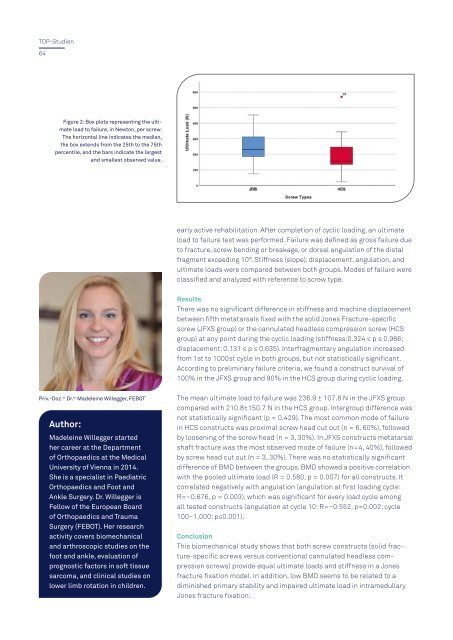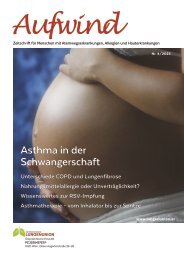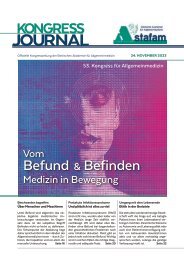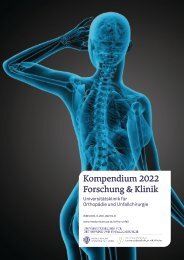Kompendium 2020 Forschung & Klinik
Das Kompendium 2020 der Universitätsklinik für Orthopädie und Unfallchirurgie von MedUni Wien und AKH Wien (o. Univ.-Prof. R. Windhager) stellt einen umfassenden Überblick über die medizinsichen Leistungen und auch die umfangreichen Forschungsfelder dar. Die Veröffentlichungen zeigen die klinische Relevanz und innovative Ansätze der einzelnen Forschungsrichtungen. Herausgeber: Universitätsklinik für Orthopädie und Unfallchirurgie MedUni Wien und AKH Wien Prof. Dr. R. Windhager ISBN 978-3-200-07715-7
Das Kompendium 2020 der Universitätsklinik für Orthopädie und Unfallchirurgie von MedUni Wien und AKH Wien (o. Univ.-Prof. R. Windhager) stellt einen umfassenden Überblick über die medizinsichen Leistungen und auch die umfangreichen Forschungsfelder dar. Die Veröffentlichungen zeigen die klinische Relevanz und innovative Ansätze der einzelnen Forschungsrichtungen.
Herausgeber: Universitätsklinik für Orthopädie und Unfallchirurgie
MedUni Wien und AKH Wien
Prof. Dr. R. Windhager
ISBN 978-3-200-07715-7
Create successful ePaper yourself
Turn your PDF publications into a flip-book with our unique Google optimized e-Paper software.
TOP-Studien<br />
64<br />
Figure 2: Box plots representing the ultimate<br />
load to failure, in Newton, per screw.<br />
The horizontal line indicates the median,<br />
the box extends from the 25th to the 75th<br />
percentile, and the bars indicate the largest<br />
and smallest observed value.<br />
early active rehabilitation. After completion of cyclic loading, an ultimate<br />
load to failure test was performed. Failure was defined as gross failure due<br />
to fracture, screw bending or breakage, or dorsal angulation of the distal<br />
fragment exceeding 10°. Stiffness (slope), displacement, angulation, and<br />
ultimate loads were compared between both groups. Modes of failure were<br />
classified and analyzed with reference to screw type.<br />
Results<br />
There was no significant difference in stiffness and machine displacement<br />
between fifth metatarsals fixed with the solid Jones Fracture-specific<br />
screw (JFXS group) or the cannulated headless compression screw (HCS<br />
group) at any point during the cyclic loading (stiffness:0.324 ≤ p ≤ 0.986;<br />
displacement: 0.131 ≤ p ≤ 0.635). Interfragmentary angulation increased<br />
from 1st to 1000st cycle in both groups, but not statistically significant.<br />
According to preliminary failure criteria, we found a construct survival of<br />
100% in the JFXS group and 90% in the HCS group during cyclic loading.<br />
Priv.-Doz. in Dr. in Madeleine Willegger, FEBOT<br />
Author:<br />
Madeleine Willegger started<br />
her career at the Department<br />
of Orthopaedics at the Medical<br />
University of Vienna in 2014.<br />
She is a specialist in Paediatric<br />
Orthopaedics and Foot and<br />
Ankle Surgery. Dr. Willegger is<br />
Fellow of the European Board<br />
of Orthopaedics and Trauma<br />
Surgery (FEBOT). Her research<br />
activity covers biomechanical<br />
and arthroscopic studies on the<br />
foot and ankle, evaluation of<br />
prognostic factors in soft tissue<br />
sarcoma, and clinical studies on<br />
lower limb rotation in children.<br />
The mean ultimate load to failure was 236.9 ± 107.8 N in the JFXS group<br />
compared with 210.8±150.7 N in the HCS group. Intergroup difference was<br />
not statistically significant (p = 0.429). The most common mode of failure<br />
in HCS constructs was proximal screw head cut out (n = 6, 60%), followed<br />
by loosening of the screw head (n = 3, 30%). In JFXS constructs metatarsal<br />
shaft fracture was the most observed mode of failure (n=4, 40%), followed<br />
by screw head cut out (n = 3, 30%). There was no statistically significant<br />
difference of BMD between the groups. BMD showed a positive correlation<br />
with the pooled ultimate load (R = 0.580, p = 0.007) for all constructs. It<br />
correlated negatively with angulation (angulation at first loading cycle:<br />
R=−0.676, p = 0.003), which was significant for every load cycle among<br />
all tested constructs (angulation at cycle 10: R=−0.552, p=0.002; cycle<br />
100–1,000: p≤0.001).<br />
Conclusion<br />
This biomechanical study shows that both screw constructs (solid fracture-specific<br />
screws versus conventional cannulated headless compression<br />
screws) provide equal ultimate loads and stiffness in a Jones<br />
fracture fixation model. In addition, low BMD seems to be related to a<br />
diminished primary stability and impaired ultimate load in intramedullary<br />
Jones fracture fixation.
















